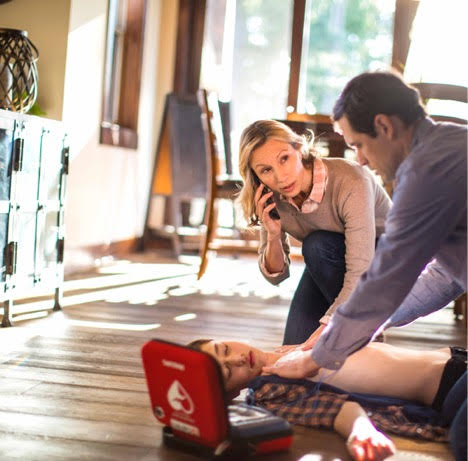When every minute counts, Penn Care works diligently to supply the best in emergency medical equipment and supplies. Sudden cardiac arrest (SCA) causes approximately 350,000 deaths in the United States every year, and only one in ten who suffer sudden cardiac arrest outside of a hospital setting will survive. That’s why Penn Care is proud to deliver the Philips HeartStart OnSite AED, an automated external defibrillator that can be used in a variety of settings: from schools and sport venues to office buildings, shopping centers, and airports.
A Defibrillator Designed for the Everyday User
Designed specifically for an ordinary person in an extraordinary event, the HeartStart OnSite AED is easy to set up and supplies voice prompts and step-by-step CPR coaching to guide users through the emergency treatment of sudden cardiac arrest. No medical training is needed to operate the device.
At just 3.3 pounds, the device is light enough to be deployed quickly by almost anybody and is suitable for treatment of cardiac arrest in persons of any age, including adults, children and even infants.
The HeartStart OnSite AED uses patented Quick Shock technology to minimize chest compression interruptions, and the device’s SMART pads sense application to the patient’s skin to intuitively align with the response process. A shock is typically delivered just eight seconds after CPR.
Preparing for When Sudden Cardiac Arrest Happens
In order to set up the HeartStart OnSite AED, users must first remove the unit from its packaging. The AED battery and AED pad cartridges should be installed. Then, the user will need to pull out and remove the green “Setup” tab to begin the device’s self-check process.
The self-check should run to completion, and once completed, the AED will instruct users to press the green “On/Off” button in the event of an emergency. Do not push this button unless there is an actual emergency.
The HeartStart OnSite AED then goes into standby mode, and the green “Ready” light will blink to indicate that the unit is ready to be used.
During a cardiac emergency, it is important to act quickly but calmly. The HeartStart OnSite AED should be located in a high-traffic area for ease of access and routine checking.
Someone suffering from sudden cardiac arrest will not be breathing normally, and will not respond when touched or shaken. If there is more than one person available, have another person call emergency services while you set up the HeartStart OnSite AED. If nobody else is available, call emergency services, then get the HeartStart OnSite AED.
Using the HeartStart OnSite AED
This intuitive device will systematically guide individuals responding to a cardiac emergency through the process of using the defibrillator.
Step 1: Activating the Philips HeartStart OnSite AED
The Philips HeartStart OnSite AED is activated by pulling on the green handle. Users are then directed to remove all clothing from the victim’s chest, pull the tab at the top of the SMART pads cartridge to remove the seal, and remove the two pads from the cartridge. (The liner from the pad must be removed, exposing the adhesive surface, and the pads should be placed on the chest exactly as indicated in the HeartStart OnSite AED manual.)
*Be sure to note any lumps or surgical scars on the victim’s chest–these could be indicators of an implanted defibrillator or pacemaker. Avoid placing the pads over these areas.
Step 2: Attaching The Smart Pads & Analyzing Heart Rhythms
Make sure to place the pads on the cardiac victim as directed. The HeartStart OnSite AED will start analyzing the victim’s heart rhythm as soon as the pads are attached. The caution light will begin flashing as an indication that nobody should be touching the victim. If a shock is required, the caution light will change from flashing to solid. The orange shock button will begin blinking and users will be prompted to press the button to deliver a shock.
Step 3: Delivering a Defibrillator Shock If Needed
Before pressing the shock button, make sure nobody is touching the victim. The device will confirm that a shock has been applied and that it is once again safe to touch the victim.
Step 4: Administering CPR After Defibrillation
After a shock has been delivered and the AED has confirmed that it’s safe to touch the victim, CPR (cardiopulmonary resuscitation) should be administered immediately. If CPR instruction is needed, the user can press the flashing blue i-button to receive voice instructions.
If the HeartStart OnSite AED determines a shock is NOT needed, the device will alert the user that it’s safe to touch the victim and begin CPR. If the victim is moving or has regained consciousness, then obey local safety protocols until emergency medical services arrive.
Use of the Philips HeartStart OnSite Defibrillator on Children
For treatment of an infant or child victim with the AED defibrillator, first begin CPR while an available person calls emergency services. If nobody else is available, perform CPR for one to two minutes before retrieving the HeartStart OnSite AED, unless you witnessed the child’s collapse.
Remove all clothing from the child’s torso, as the pads will be placed on the child’s chest and back. Place one pad on the center of the chest and the other in the center of the back. The HeartStart OnSite AED will automatically reduce the charge to an appropriate level for a child or infant victim. Pediatric CPR coaching can be provided from the device, if needed, as well.
If infant/child pads are not available, or if the child is over 8 years of age or 55 pounds, use the adult SMART pads and place them as shown for an adult in the HeartStart OnSite AED manual.
There are certain situations where the HeartStart OnSite AED, or any defibrillator, should never be used. If the victim is in water or excessively sweaty, the device should not be used. It should never be operated around oxygen containers or other combustible materials, and you should never attempt to use the HeartStart OnSite AED on yourself.
Trust the Reliability of the Philips HeartStart OnSite AED
Philips is a worldwide leader in AED machines, and the HeartStart OnSite AED is the first and only AED available without a prescription. This package includes the defibrillator, a lithium battery pack, an adult SMART pads cartridge, the owner’s manual, a quick reference guide, and setup and maintenance guides. Training pads can also be installed in the device that disable the unit’s ability to deploy a shock so that users can engage in practice scenarios.
The HeartStart OnSite AED performs daily self evaluations of all systems and the AED battery. The AED package also runs tests to confirm that the pads are installed properly. A blinking green “Ready” light lets potential users know that the unit is ready for use when needed.
Cleaning and Caring For the AED Defibrillator After Use
After using the Philips HeartStart OnSite AED, check the outside of the unit for damage or dirt. Cleaning should be performed with a soft, damp cloth and soapy water. Ammonia-based cleaners can also be used, or a mixture of 2 tablespoons of chlorine bleach diluted in a quart of water.
Never use rubbing alcohol, acetone-based or enzymatic cleaners to clean the HeartStart OnSite AED. Do not submerge the unit in any liquids or allow liquids to spill onto it. Sterilizing the Philips HeartStart OnSite AED or any of its components is not necessary.
Philips SMART pads are single-use and must be replaced after deployment. To install new electrode pads, use the latch on the top of the unit and slide it aside. This will release the cartridge lock and allow the spent cartridge to be removed. Open a new SMART pads cartridge out of its packaging and slide it into the cartridge recess. When the cartridge is properly placed, there will be an audible click. Ensure the green “Pull” handle is all the way down. Then, record the replacement of the cartridge on the maintenance tag.
Unless your local protocol dictates otherwise, remove the battery for five seconds and then reinstall it. This will initiate the device’s battery self-check and confirm its readiness. When instructed, press the “Shock” button and allow the self-test to run completely. Check to see that the green “Ready” light is blinking.
On the maintenance tag, be sure to record the expiration date of the installed SMART pads cartridge, along with the expiration dates of any spare cartridges or batteries. Place the device into its slim carry case, and secure the Quick Reference Guide (user manual) face up in the clear plastic window on the inside of the wall cabinet before putting the device back in its storage location.
The HeartStart OnSite AED stores data automatically for 30 days following its last use. This data can be transferred to a computer or device for review using the Philips HeartStart Event Review data management software. Obey local safety protocols concerning the handover of that data to the appropriate medical personnel. The last-use data stored includes ECG (electrocardiogram) recording for 15 minutes following application of the SMART pads, the status of the OnSite device for the duration of its use, the OnSite’s rhythm analysis decisions for the entire incident, along with the elapsed time associated with the entire event.
Caring for the Philips HeartStart OnSite AED
You should always establish a schedule for performing periodic checks to the HeartStart OnSite AED.
First, make sure that the green “Ready” light is blinking. Check any spare accessories for damage, and replace any that are expired. Inspect the unit for cracks or damage, and if damage is present, contact Philips technical support for assistance. All regular maintenance checks should be recorded in the inspection log.
It is recommended to have a spare replacement battery and spare SMART pads with the Philips HeartStart OnSite AED, and these can be purchased separately. Child/infant SMART pads are also strongly encouraged if the unit will be placed in a school or other setting where children could possibly require treatment. Other suggested accessories include scissors for cutting through clothing, disposable gloves to protect the user, a disposable razor for removing chest hair if the pads cannot make good contact, a mask or face shield to protect the user, and a towel or wipes to dry the skin for good pad contact. These items are available in a Philips Fast Response Kit.
The Philips HeartStart OnSite AED comes with an 8 year warranty on the unit. SMART pads are warranted until the expiration date printed on the package. And, the included 9 volt DC battery has a standby life of four years and an install date of 5 years from its date of manufacture.
Get Your Philips HeartStart Onsite AED From Penn Care, Your Trusted Provider
No other commercially available defibrillator can match the HeartStart OnSite AED’s capabilities for ease of use and cost effectiveness. Philips’ unique capacitor technology means that victims receive the highest peak current in the first shock delivery, versus other manufacturers’ devices that only escalate to higher levels if necessary.
That escalation process can mean an unnecessary wait of up to six minutes before the victim receives a full shock. With Philips SMART Analysis and CPR coaching, it’s almost like having a trained emergency medical technician by your side. Again, there is no need to be a trained first aid responder to use this device (professional grade AED options from Philips include other devices, like the rugged HeartStart FRx AED).
For more information about the Philips HeartStart OnSite AED, or other reliable Philips products, contact Penn Care, your trusted leader for emergency medical supplies and equipment.



